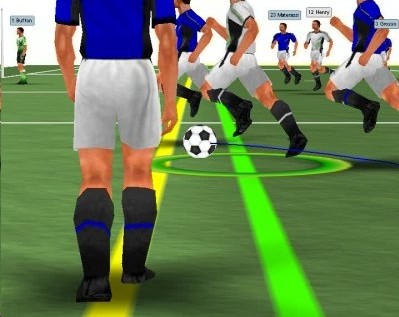Harun Farocki
10 Jan - 09 Feb 2008
HARUN FAROCKI
"Deep Play"
Greene Naftali Gallery is pleased to present the second New York solo exhibition of Harun Farocki. A legendary German filmmaker and artist, Farocki has, for four decades, mined the uneasy relationship between the history of cinema and the impact of new image technologies on global political consciousness. The artist will present a monumental 12-channel video installation that unpicks, screen for screen, the spectacular architecture that lies at the heart of sports broadcasting, its analytic tools, and its technologies.
A formal expansion of the artist's essay films, Deep Play brings together 12 different vantages on one of the biggest television events to emerge in the new millennium--the 2006 FIFA World Cup. The event, held in Germany, was reportedly seen by an estimated 1.5 billion viewers worldwide. Unfolding in simultaneous, real-time montage, Deep Play depicts the artist's own footage of the game, official FIFA footage, charts of player stats, real-time 2D and 3D animation sequences, and stadium surveillance, exposing the visual, informational, and technological design of these grand cultural spectacles. Though visually bombarding at points, the network of images and data stages a reprocessed disarticulation of spectacle, aptly pointing out the present conditions of visuality and its overwhelming influence on representation and subjectivity.
The questionable use of image technology by a deeply rationalized society forms the critical core of Farocki's work. In his Eye/Machine trilogy (2001-2003), the artist edited together footage depicting the developments in robotic technology with that of military technology, explicitly pointing out the implications of one to the other. In the case of Deep Play, the work's criticality is embedded in the experiential overload of visuals and data and the uncanny effect of seeing players translated, in real time, into ciphers of statistical units and polyagonal avatars. In a sense, what is at question here is the visualization of the real and its effect on social and political behavior. The scrutiny of images down to a tenth of a second is standard for not only the reportage of sports but also for their regulation. Can we better understand Zidane's--who is of Algerian descent and, at the time of the match, was France's most popular player--motives by seeing his avatar controversially head butt the Italian Materazzi?
The desire to visualize events--in this case, one of international interest--down to every last mechanic detail suggests a menacing subjective displacement of the human for the computerized, of the political for the technological, or to quote Carl Schmitt, as cited in Farocki's essay, Dog from the Freeway: "If the inner immanent rationality of the technically organized world is implemented completely, then the partisan will perhaps not even be a troublemaker...he will vanish of his own accord in the frictionless performance of technical-functional processes, no different than the disappearance of a dog from the freeway."
"Deep Play"
Greene Naftali Gallery is pleased to present the second New York solo exhibition of Harun Farocki. A legendary German filmmaker and artist, Farocki has, for four decades, mined the uneasy relationship between the history of cinema and the impact of new image technologies on global political consciousness. The artist will present a monumental 12-channel video installation that unpicks, screen for screen, the spectacular architecture that lies at the heart of sports broadcasting, its analytic tools, and its technologies.
A formal expansion of the artist's essay films, Deep Play brings together 12 different vantages on one of the biggest television events to emerge in the new millennium--the 2006 FIFA World Cup. The event, held in Germany, was reportedly seen by an estimated 1.5 billion viewers worldwide. Unfolding in simultaneous, real-time montage, Deep Play depicts the artist's own footage of the game, official FIFA footage, charts of player stats, real-time 2D and 3D animation sequences, and stadium surveillance, exposing the visual, informational, and technological design of these grand cultural spectacles. Though visually bombarding at points, the network of images and data stages a reprocessed disarticulation of spectacle, aptly pointing out the present conditions of visuality and its overwhelming influence on representation and subjectivity.
The questionable use of image technology by a deeply rationalized society forms the critical core of Farocki's work. In his Eye/Machine trilogy (2001-2003), the artist edited together footage depicting the developments in robotic technology with that of military technology, explicitly pointing out the implications of one to the other. In the case of Deep Play, the work's criticality is embedded in the experiential overload of visuals and data and the uncanny effect of seeing players translated, in real time, into ciphers of statistical units and polyagonal avatars. In a sense, what is at question here is the visualization of the real and its effect on social and political behavior. The scrutiny of images down to a tenth of a second is standard for not only the reportage of sports but also for their regulation. Can we better understand Zidane's--who is of Algerian descent and, at the time of the match, was France's most popular player--motives by seeing his avatar controversially head butt the Italian Materazzi?
The desire to visualize events--in this case, one of international interest--down to every last mechanic detail suggests a menacing subjective displacement of the human for the computerized, of the political for the technological, or to quote Carl Schmitt, as cited in Farocki's essay, Dog from the Freeway: "If the inner immanent rationality of the technically organized world is implemented completely, then the partisan will perhaps not even be a troublemaker...he will vanish of his own accord in the frictionless performance of technical-functional processes, no different than the disappearance of a dog from the freeway."

